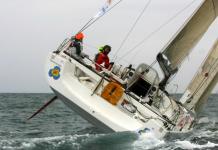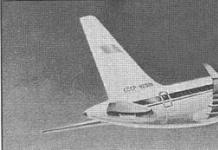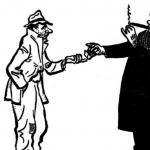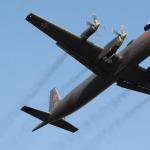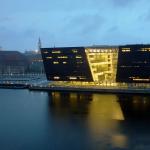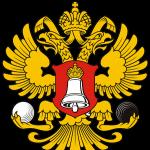You denigrate the Sukhoi Superjet! - they will tell us. – Yes, unlike the “Soviet” times, this machine was developed in record time according to all market rules, and it turned out - wow!
Yes, “wow” that’s what happened. Let's describe the history of this strange enterprise, which resulted in something very similar to Adam Kozlewicz's Wildebeest. He always hesitated about what to call his miracle of technology - either “Lauren Dietrich” or “Panhard-Levassor”. Because the machine was assembled from different parts.
The Sukhoi Superjet resembles Kozlevich’s car. This “first post-Soviet aircraft” did not become any breakthrough. There is every reason to believe that he will never get on the line. And the history of its hasty creation very clearly depicts the quality of public administration in the Russian Federation.
So, it all started with the fact that by 1999 the Russian Federation had a truly production-ready aircraft - the Tu-334. The class is similar to the so-called “Superjet”. And it was like this.
In 1999, Nikolai Nikitin became the new general director of the MiG company: a controversial but energetic man. He realized that the company would not survive on military orders alone - and decided to also produce a civilian aircraft. Yes, yes, the already developed Tu-334. The then First Deputy Prime Minister (the last head of the USSR State Planning Committee, Yuri Maslyukov) allocated funds for this, and Nikitin equipped production facilities in Lukhovitsy. A contract was even signed with Iran for $1.6 billion for the production of one hundred 334s. Iranians generally love Tupolev cars. Their Tu-154s are still flying. The thrust-to-weight ratio of such airliners is excellent. More Western, although the efficiency is worse. In the high mountainous and hot Iran, where the air is thin and “liquid” due to the high temperature and altitude, Western-made passenger cars fly mainly at night. And Tupolev aircraft in Iran can make flights during the day. I myself visited the Iranians and saw how much they love our Tu. The Iranians are eager to get the Tu-334. However, Nikitin made a mistake. He calculated the cost of one airliner at 12 million dollars - and prices in the Russian Federation went up sharply. It was necessary to reconsider the contract, but Tehran refused. If there was a normal state in the Russian Federation, it would help MiG and Tu and provide subsidies for the production of one hundred cars. Is it a joke - hundreds of new airliners, and with the prospect of gaining a foothold in the Iranian market? One hundred passenger airliners is ten times more than what was done in the Russian Federation in 2008. If the government had acted this way, today the Tu-334 would have been in production for five years already, as a serial production aircraft, flying both in the East and in the Russian Federation itself. But no - the government is ugly. The contract fell apart. Nikitin was removed. The new management of RSK MiG abandoned plans to produce the Tu-334.
And then the authorities started talking about the need to make the first post-Soviet passenger airliner. Putin's friend Sergei Ivanov talked about this. He was supported by the then head of the Ministry of Economy, the “great genius” G. Gref. Like, a competition is needed.
What the hell is a competition when there was already a finished and certified aircraft? When was the only time left to build it?
Our macaque rulers are not interested in this. Another thing is interesting: to take and spend a lot of public money again, throwing away a ready-made project (this was the case in the case of replacing the “Bark” with the “Bulava”, as you remember). Why is this being done? You don't need to explain anymore. Why is the Tu-334 needed if it has been developed since 1992, and its entire creation required about 100 million dollars. They told us: “Soviet” design bureaus are good for nothing, they are expensive, inflexible - and other nonsense. In fact, 100 million dollars is very modest. The companies Embraer and Bombardier spent 600 million each on the development of similar machines.
The ruling monkeys in the Russian Federation, having rejected the Tu-334, decided to develop a new aircraft. The competition was won by the Sukhoi company, which promised to develop a super-duper breakthrough machine without attracting government funds. She was declared the winner. But then it turned out that the development would be funded by the state. According to some sources, they spent $1.2 billion on it, according to others (if we count all government guarantees for loans) – 2 billion.
2 billion and 100 million is a difference of twenty times. It turned out like the joke about the new Russians:
How much did you buy the tie?
- For a thousand bucks!
- Fool, they sell it around the corner for one and a half...
In general, the money was spent. The order for the production of a passenger airliner was given to a company that did not have the slightest experience in creating civilian aircraft. A company that had screamed before, but never developed a civilian S-80. It does not have its own production base for this. As a result, they spent seven long years and billions of dollars on who knows what, “cutting down” a real plane.
To create the Sukhoi Superjet, a special legal entity was created - GSS (Sukhoi Civil Aircraft). They rented an office for her in the McDonald's building, which is behind the Central Telegraph in Moscow. Design teams changed like gloves. And as a result, this... eroplane was born.
Everything here amazed and left me dumbfounded from the very beginning. For example, Boeing was hired as a consultant for the project. Who advised with all her might, without investing a single cent into the project. How shoud I understand this? In fact, Boeing is not at all interested in the rise of our aviation industry. We are his competitors. It’s as if Stalin, to create a new tank, would have invited Porsche from Hitler’s Germany as consultants. Or Heinz Guderian. But, as you can see, in the Russian Federation this is also possible. "Boeing" and advised in full. In addition, the Italian company Alenia bought a quarter of the shares (blocking stake) in the State Insurance Company.
As a result, an aircraft was born that cannot be called a breakthrough. It is 80% made from foreign-made finished parts. That is, it is already a car of yesterday. An interesting detail: the doors for the SSJ are supplied by Boeing. For 2 million dollars. And at Tupolev they make an entire airplane glider for 3 million. The body of the Sukhoi Superjet is made of metal. While Boeing, on its B-787 Dreamliner, makes an airframe from ultra-strong and ultra-light composites.
The engines under the wing of the notorious “superjet” are located only 42 centimeters from the ground (if you count from the lower edge of the air intakes). Engines are not installed so low on any aircraft in the world. That is, at regional airports of the Russian Federation it will absorb debris and debris from the runway surface: the condition of our local airports is not ideal. It was not ideal in the USSR either. But on the Tu-134 and Tu-154, the engines are not located under the wings, in the tail, high from the surface of the airfield. Although, sometimes, fragments of the coating were carried into them. SSJ will work like a vacuum cleaner. It’s not for nothing that during testing they carry him to the strip with a tractor, not allowing him to steer himself. To prevent anything from being sucked into the engines. So it turns out: for this aircraft, all regional airports of the Russian Federation will have to be remodeled, at a cost of countless billions of dollars. Is this possible? And will such a plane be able to fly in the Russian Federation - although so much money and time have already been spent on it?
Go ahead. In this case, the passenger plane was made by those who previously made fighter planes. But there are completely different design approaches here! The fighter (its airframe) is designed for a service life of 2 thousand flight hours, and the airliner - for 70 thousand hours. In general, a fighter is designed at risk, with the expectation of fine-tuning. In fact, military pilots fly it without passengers, and if something happens, they can eject. It is not for nothing that the first series delivered to the troops, as a rule, still suffers from “childhood diseases”. Accidents of new machines in military aviation are treated quite tolerantly: they say, what can you do - the costs of novelty. We'll work on it as we go. But a passenger car is completely different! Here, a couple of crashed planes mean hundreds of human lives. Therefore, in the USSR, passenger cars were “licked” to the limit.
And here they offer us a “raw” car.
The Sukhoi Superjet had problems with the skin and the hull in general. The fact is that the frames on Russian liners were bent from sheet metal. Although this is labor-intensive, it is reliable. Consultants from Boeing advised installing milled “ribs” on the SSJ. At the same time, the Yankees themselves do not do this. It seems that they decided to try this technology on those they don’t mind. And the skin on the superjet had to be made thicker, abandoning chemical milling. Despite the fact that the weight of the car does not seem to have changed.
SSJ was made from foreign-made finished parts. That is, the release of these super-duper jets will not contribute in any way to the rise of the domestic aviation industry. The engine (SaM-146) is French, converted and not certified. And on the Tu-334 we have our D-436DT1 engines, and they are certified. The auxiliary power unit (APU) on the Tupolev is ours, and on the SSJ it is imported from Honeywell. Tu-334 consists of only 5% imported parts and components. The fuel efficiency of our aircraft is 22.85 g/passenger-kilometer. The “superjet” has 24.3 (if you believe what is stated). The interior of our car is more comfortable (3.8 by 4.1 m versus 3.4 by 3.6 m in the SSJ). The Tu-334 is unified in serial production with the Tu-214, but the “superjet” is not. The technical staff of our airlines already have experience in servicing aircraft unified with the Tu-334 (Tu-204 and Tu-214), but the “dry airliner” cannot boast of this.
Another important point: by producing the Tu-334 in series at the Kazan KAPO named after Gorbunov, the country retains the ability to repair long-range missile carriers/bombers Tu-160 and Tu-22M3. Without the Tu-334, all this is lost.
The “liner of the future” should actually be serviced abroad: there are so many imports in it. The brakes are from Goodrich, the hydraulic system is from Parker. The electrical system is supplied by Artus, SAFT and Leach International. On-board electronics on the SSJ are from Thales. In fact, this is a “screwdriver assembly” machine, a national disgrace. Even the Ministry of Economic Development has now admitted this in the notorious 2020 strategy, shyly calling the “superjet” an “intermediate option.” This airplane is not a “breakthrough” at all. He is a frankly “student’s” car (dammit, ugly duckling). A sort of visible embodiment of the manic dream of the Russian “elite” about integration into the world economy at any cost. In this case, at the cost of losing its aviation industry. And all this is presented as “the success of the new Russia”! Even the United Aviation Corporation is increasingly calling the promising MS-21 the aircraft of the future, which must be worked on in collaboration with those parts of the USSR aviation industry that remained in Ukraine.
It is unlikely that it will be possible to supply SSJs abroad. The Chinese have their own 100-seat “regional”, the Japanese have theirs, Brazil and Canada make similar aircraft. And in general, it’s not clear: will this “miracle” fly on real flights, despite the heaps of money thrown at it?
In general, we decided to make a white-blue-red plane - and this is what came out of it. No intelligence, no imagination, no innovative breakthrough. And it turned out much worse in the “super-market version” than in Soviet design bureaus. The USSR was not afraid to make truly breakthrough machines that were ahead of the West. These were Tu-104, Antey and Ruslan. And here is something screwed together from the Western world of yesterday. And this is the hope of the Russian aviation industry? Yes, the ruling freaks are definitely ruining the aircraft industry.
The most interesting thing is that Putin, being first the President of the Russian Federation, and then becoming the Prime Minister, twice ordered the start of mass production of the Tu-334 in Kazan. This was November 7, 2007 and September 9, 2008. The last time, Putin even asked why his orders were not carried out. True, he didn’t punish anyone. Like, do it. But no one even bothered to do it. Well, the United Aircraft Manufacturing State Corporation doesn’t want this plane – and that’s all. They generally want to transfer the Kazan Association named after Gorbunov to a clean renovation.
N-yes, it’s hard to imagine that someone would dare to ignore the orders of, say, Stalin like that. And in his case - an authoritarian vertical of power, and in the current one. But the efficiency of the two systems, to put it mildly, varies. It is no wonder that in the USSR we moved mountains in the shortest possible time and created advanced technology, but in the Russian Federation we have been marking time practically in one place for years, sometimes producing real “technical bastards.”
What do we have in the “bottom line”? The epic with the first “post-Soviet airliner” most clearly depicts what is happening in the agonizing and degrading Russian Federation. The desire of its “elite” to “fit into the global division of labor” at any cost (even at the cost of outright idiocy), destroying its own scientific and industrial base and leaving only “screwdriver production” in the Russian Federation. Compared to Soviet times, all this is a huge setback.
A “screwdriver plane” would be acceptable for a country that did not have its own aircraft industry. For some Malaysia. But for the Russians, with their almost century-long history of designing and building advanced airships, this is a national disgrace.
In this particular case, we are offered a “screwdriver plane” at the level of a MAI graduate’s graduation project. An airplane whose future as a production machine is a huge question mark. At the same time, three times more money was spent on the “sukhoi-superjet” epic than aircraft manufacturers spend abroad on the same enterprises. Six times more than the development of the regional Russian-Ukrainian An-148 (about 300 million dollars) and almost twenty times more than the Tu-334.
A characteristic feature of the “white-blue-red elite”: terrible incompetence and laziness, coupled with the desire to spend as much money as possible - in order to bite off more of it and saw off for themselves personally. This is what will bring the Russian Federation to complete collapse.
That's the whole story about the abilities of the current tricolor state in organizing the aircraft industry. That is, they simply kill him. And after the murder of the civilian aircraft industry, problems will inevitably begin in the military aircraft industry. These are communicating vessels.
For reference:
In 1992, the Russian aviation industry produced 77 mainline airliners. Twice less than in the USSR.
In 1993 – 68.
In 1994 – 27.
In 1995 – 19.
In 1996 (“Vote for Yeltsin or lose!”) – 4.
In 1997 – 5.
In 1998 – 9.
In 1999 (Putin’s arrival) – 7.
From 2002 to 2005, airlines purchased only 20 domestically produced aircraft. That is, their production in the Putin era amounted to 6-7 cars per year. At the level between 1997 and 1998.
The following quantities of civil aircraft and helicopters were produced in 2004:
12 aircraft (without light ones), including:
passenger mainline and regional – 7 aircraft: Il-96-300 – 3 (including cabin, Voronezh), Tu-214-1, Il-62M – 1 (Kazan), An-38 – 2 (Kazan), . Novosibirsk);
cargo - 3 aircraft: An-124 "Ruslan" -2 (Ulyanovsk); An-74 – 1 (Omsk);
special - 2 aircraft: Be-200 - 2 (Irkutsk).
Try to find data on the production of airliners in subsequent years - you will get tired.
In 2008, after eight years of “rising from our knees” and the influx of trillions of “petrodollars”,... 8 airliners were built.
Short-haul passenger aircraft, launched into series
Experienced Tu-334, joint tests, spring 1999
On February 8, 1999, at 12:50 Moscow time, the short-haul passenger aircraft Tu-334, created at JSC ANTK im. A.N. Tupolev in collaboration with a group of Russian and Ukrainian enterprises. For the first time since 1991, a new type of civilian passenger aircraft was flown in Russia (before that, the last Russian passenger aircraft, the Il-114, made its first flight in 1990).
In the first flight, which lasted 31 minutes, the aircraft was piloted by a crew of test pilots from the A.N. ASTC. Tupolev consisting of: ship commander A. Soldatenkov, co-pilot S. Borisov, E. Kuzmin, E. Kudryavtsev and A. Filippsky. The crew highly appreciated the stability and controllability of the vehicle and noted its high takeoff and landing characteristics.
The first flight of the Tu-334 marked the end of a ten-year period of work by ANTK to create a promising short-haul aircraft to replace the well-known Tu-134. Design of the Tu-334 began in 1988. When laying down the project for a new “short-haul aircraft,” ASTC followed the path of extensive unification of many design elements of the Tu-334 with the design of the medium-haul Tu-204, which should have resulted in significant savings in cost and time. This approach was justified and stemmed from the experience of ANTK, which created in the late 50s - early 60s the successful short-haul jet airliner Tu-124, which had a large degree of continuity in aerodynamic, structural design and equipment with the medium-haul Tu-104 aircraft. The layout of the Tu-334 was almost completely consistent with the design of the Tu-204, but its dimensions and weights were significantly smaller. The project provided for a high degree of unification in units and systems with its medium-haul progenitor. In the tourist version, the car was designed to carry 100 passengers with a seat pitch of 810 mm over a range of 2000 km. In the cabin version - for 22 passengers, the range was supposed to reach 6000 km.

Project Tu-334, 1988

to carry 100 passengers with a seat pitch of 810 mm for a range of 2000 km. In the cabin version - for 22 passengers, the range was supposed to reach 6000 km.
The power plant was supposed to include two engines with a high bypass ratio of the SVD type (we were talking about a TVVD project with a multi-bladed screw installation in an annular channel, with a static thrust of 8000-9000 kgf, with cruising thrust at an altitude of 11000 m and at M = 0.78 - 1600 kgf with specific fuel consumption in this mode of 0.51 kg/kgf hour). The diameter of the fuselage was to match that of the Tu-204, but much shorter. This approach made it possible to accommodate passengers with a high degree of comfort inherent in larger mainline aircraft. The underground space of the fuselage was occupied by a capacious cargo compartment, designed to transport standard containers. All this expanded the range of application of the future Tu-334 and, to a certain extent, brought the project closer to the Tupolev projects of mainline aircraft of the early-mid 70s. According to the design data, the Tu-334 in its original version was supposed to have the following basic data:
wingspan – 29.2 m,
aircraft length - 28.6 m,
aircraft height – 11.1 m,
take-off weight – 39000 kg,
cruising flight speed – 800-830 km/h,
flight range (95 passengers) – 2300 km,
required runway length – class B,
fuel efficiency – 17-17.5 g/pass km
Later, with the emergence of options for using real propeller-fan engines of the D-227 type (without an annular channel), with a take-off thrust of 8000-9000 kgf, the original project was reworked to accommodate the engines in the rear fuselage. By the beginning of the 90s, two modifications of the Tu-334 were in design: the first with a D-436T turbofan engine (takeoff thrust 7500 kgf, cruising thrust at an altitude of 11000 m and at M = 0.75 - 1300 kgf, with a specific fuel consumption of 0 .63 kg/kgf hour) and the second with propfan engines with pushing multi-blade propellers.
The option with a high-pressure propulsion engine assumed the creation of an aircraft with four possible passenger cabin layouts: in the tourist version with 126 seats (seat pitch 810 mm), in the economy version - with 137 seats (seat pitch 750 mm), in the mixed version - with 116 (1st class – seat pitch 1020 mm – 8 seats, tourist – 108 seats) and in a mixed version for 104 seats (1st class – 8 seats, with a seat pitch of 960 mm – 12 seats and tourist – 84 seats). The version with D-436T engines provided for three main layouts: tourist version - for 102 seats, mixed - for 92 seats (1st class for 8 seats, tourist - for 84 seats) and mixed - for 86 seats (1st class - for 8 seats, with a seat pitch of 960 mm - 12 seats, tourist - 66 seats). Both versions of the aircraft had the following basic design data:

Problems associated with the use of HPT on an aircraft of this class forced ANTK to soon completely focus on only one project, the Tu-334 with the D-436T. By the mid-90s, the first Tu-334 was almost completed and was publicly presented at the Mosaeroshow-95 exhibition. Then, for almost three years, the aircraft was equipped with the necessary equipment and conditions were provided for the start of flight tests.
The Tu-334 aircraft is designed according to the monoplane design, mastered and widely used for short-haul passenger aircraft, with a low-mounted swept wing of moderate sweep, with engines located in the rear part of the fuselage on pylons, and a stabilizer at the top of the fin. The landing gear is tricycle with a nose strut. Features of the landing gear include the use of a fly-by-wire braking system with automatic switching to a forced mode of stopping the aircraft during an aborted takeoff.

A wing with high aerodynamic characteristics and a perfect design was designed for the Tu-334. The basis of the wing's structural design is determined by the caisson-tank, consisting of a center section and two detachable consoles with vertical aerodynamic tips that reduce induced drag. There are no removable panels on the wing, which increases the resistance of the structure to external loads and simplifies the production technology of the unit. Access to the caisson is through access hatches in the lower wing panels. Rolled and pressed parts up to 13 meters long are used in the wing skin and internal strength set. The wing controls and mechanization are of a honeycomb structure made of composite materials. The tail organs have a similar design.
The aircraft fuselage is technologically divided into nose, middle and tail sections. The units and fuselage sections are complete units with the floor frame installed and interior parts partially assembled.
The on-board air conditioning system (AAC) is designed and manufactured using advanced technologies from leading Western companies, as well as taking into account the operation of domestic passenger aircraft in various conditions. In terms of performance, low noise and reliability, it is at the most modern level. The two-class layout of the cabins necessitated the installation of front and rear doors on the left side. It is planned in the future to equip the aircraft with manufactured ladder doors. When creating the aircraft, modern approaches were used in the design and design of the passenger cabin and the pilot's cabin. Thanks to modern and ergonomic interior decoration, the use of noise-absorbing structures, as well as a wide central aisle and large seat pitch, the Tu-334 passenger cabin is one of the most comfortable among aircraft of this class. The cockpit, similar to the cockpit of the Tu-204 aircraft, allows for comfortable working conditions for the pilots.
The basic layout of the tourist class passenger cabin is designed for 102 passengers with a seat pitch of 810 mm. The layout principle of the passenger cabin and service modules (toilets, kitchens and wardrobes) allows the Tu-334 to be used in various alternative versions that meet the wishes of specific customers. Luggage and cargo are placed in two cargo compartments: front and rear (10 and 6.2 cubic meters). Capacious overhead bins are provided for carry-on luggage. The crew cabin, similar to the Tu-204 cabin, allows for comfortable working conditions for a crew consisting of two to three people (the third is a flight engineer). The cockpit is designed using electronic display screens and an automatic flight control system. The status of the main flight navigation and aircraft systems is displayed on color displays. The standard navigation system installed on board provides automatic navigation coordinated with the optimal trajectory program during landing according to ICAO category IIIA. The external communication system provides the ability to establish precise constant communication with the mission control center on VHF and HF frequencies.
The aircraft is equipped with two D-436T1 turbojet engines, developed at the Ukrainian ZMKB Progress. These engines have high technical characteristics, high efficiency and fully comply with current and future (taking into account the latest changes) ICAO standards for external noise and emissions.
In 1999, the first Tu-334 "001" completed 43 flights under the program of factory development and factory certification tests, of which 3 were certification; 19 training and demonstration flights, including at the MAKS-99, Dubai-2000 and Tehran exhibitions. During the flights, the aircraft reached flight modes at speeds corresponding to M = 0.76 and flew at altitudes up to 10,500 m. During the flights, the specified operational overloads and maneuvering characteristics of the aircraft were achieved. The airframe of the second machine "002" is undergoing a cycle of static tests at TsAGI.
The following aircraft of the pilot batch are produced at enterprises in Russia and Ukraine: Tu-334 "005" is being built by RSK "MiG", which is determined by the main manufacturer of the Tu-334, the aircraft is intended for certification flight tests, the start of flight tests of the machine is scheduled for the second quarter of 2001; Tu-334 "003" is being assembled in Ukraine by KiGAZ "AVIANT" - also intended for flight testing, RSK "MiG" has joined the work on the vehicle, it is expected that the aircraft will be ready in the fourth quarter of 2000 and will begin flying under the test program; Tu-334 "004" was manufactured at KiGAZ "AVIANT" and transferred to ANTK and is intended for endurance testing at the ANTK stand. Such a wide scope of work on the pilot batch should ensure, subject to normal funding for the project, obtaining a certificate for the Tu-334 in 2001-2002, with the simultaneous deployment of the series and the start of operation.

Tu-334, joint tests

Tu-334 cockpit

Salon Tu-334
To date, a system of cooperation for the production of serial Tu-334 has been defined. Joint solutions for the production of the basic serial type Tu-334-100 (102-seat aircraft with a wing area of 83.2 m 2 and a flight range of 3150 km) are connected to the ASTC named after. A.N. Tupolev, RSK "MiG" - the main one, AVIANT (Kyiv) and JV "AVIASTAR" (Ulyanovsk) - production of units, and in the future, full-scale production of one of the modifications of the Tu-334.
The confidence of the creators of the Tu-334 in the commercial success of their project is based not only on the rich experience of designing and creating long-haul aircraft at the ASTC, but also on the projected market demand for modern short-haul aircraft (in the near future there will be a mass decommissioning of the obsolete aircraft currently flying class). The promising prospects of the aircraft in the CIS markets, the potential capacity of which is estimated at more than 600 units for the period until 2010, are confirmed by signed agreements of intent with various airlines. A number of foreign countries have shown and are showing interest in the aircraft, in particular China, Iran, Germany, etc.
The Tu-334 program involves the creation of a family of aircraft for various purposes based on the basic design of the Tu-334-100. The family will have to include passenger and cargo aircraft of various sizes, with different types of engines and with a variable composition of equipment. Throughout the 90s, the ASTC worked on the following main versions of the Tu-334 aircraft:
– Tu-334-100 – the main version with D-436T1 engines, with a passenger capacity of 102 people, a flight range of 3150 km, with a wing area of 83.2 sq.m;
– Tu-334-120 – modification of the Tu-334-100, for Western engines of the BR710-48 type;
– Tu-334-100D – a version with an extended fuselage, a wing of increased span and area, with D-436T2 engines, an increased flight range exceeding 4000 km;
– Tu-334-120D – Tu-334-100D variant – with Western BR715-56 engines;
– Tu-334-200 – version with extended
a new fuselage, a wing of increased area, with D-436T2 engines, passenger capacity increased to 126 people, and a flight range exceeding 4000 km;
– Tu-334-220 – a variant of the Tu-334-200 with Western engines of the BR715-56 type;
– Tu-334-100S, Tu-334-220S – cargo versions of the corresponding passenger modifications.
In addition to these options, in the future it is possible to create on the basis of the Tu-334 a training aircraft for educational units, combat units of the Air Force and Navy aviation according to the type of production of the corresponding variants, as was done in the 70s and 80s on the basis of the Tu-134A ( Tu-134111 and Tu-134UBL aircraft, which are in service in the Air Force to this day, the problem of replacing which will sooner or later face the Air Force command).
It should be noted that the Tu-334, even in its first basic version - the Tu-334-100, is at the level of its Western analogues, and in some respects even slightly exceeds them. This trend should continue as the type develops in its subsequent modifications. All this confirms the high competitive potential of the new Tupolev aircraft in domestic and international markets. Below is a comparative table of the main technical and economic characteristics of the Tu-334-100 and its Western analogues.
The current state of affairs on the Tu-334 and the prospects of the program can be judged by the speeches at the presentation of the Tu-334 with BR715 engines held on May 30, 2000 in the premises of the A.N. Tupolev ASTC business center for a potential customer - JSC Aeroflot - Russian international airlines."
Comparative characteristics of the Tu-334-100 aircraft and its analogues

This event was distinguished by wide representation. It was attended by: Advisor to the President of the Russian Federation E. Shaposhnikov, Deputy. Director of Rosaviakosmos Yu. Bardin, Gen. Director of JSC Aeroflot - Russian International Airlines V. Okulov, Gen. Director of the A.N. Tupolev ASTC V. Aleksandrov, Chief. Tu-334 designer I. Kalygin, First Deputy. gene. Director of RSK "MiG" A. Gerasin, as well as representatives of the RF Ministry of Defense, AVIANT and Rolls-Royce Deutshland.
Y. Bardin, who spoke first, emphasized that the Tu-334 project is a priority for Russia in 2000. The aircraft, intended to replace the Tu-134 fleet, is proposed to be put into production at four factories - AVIANT (Kyiv), RSK MiG (Moscow), AVIASTAR (Ulyanovsk) and in Taganrog. Y. Bardin emphasized that the cost of the aircraft, amounting to 17 million USD, is significantly lower than its foreign analogues. The Tu-334-100 will be able to use 65%, and the promising Tu-334-200 – 90% of Russian airports, in contrast to the latest modifications of the B-737, which can use only 45%. Rossaviakosmos expects that the Tu-334 will become the most popular aircraft in its class in the 21st century. The leading role of RSK MiG in the revival of the Tu-334 project was noted, the financial injections of which made it possible to intensify work on the Tu-334 program.
The chief designer of the Tu-334, who spoke, noted that the specifications for the aircraft were formulated more than 10 years ago, and the performance characteristics of the Tu-334 meet the new requirements of potential customers. Thus, according to the old technical specification, the flight range with 100 passengers should have been 2000 km. Today more than 3500 km are required. In fact, with domestic engines and the necessary ANZ, the flight range is 3200 km, and with engines like BR715 - 4000 km. The American B-717 can only compete with the Tu-334-100. The subsequent modification of the Tu-334-200 is actually a medium-range aircraft. To increase efficiency, it is planned to create a whole family of aircraft based on the Tu-334. The modifications will differ not only in carrying capacity, fuselage length, but also in wing area. Thus, Tu-334-100 and -120 will have a load capacity of 12 tons and a wing with an area of 83 sq.m., and Tu-334-100D, -120D, Tu-334-200 and -220 will have a load capacity of 15 tons and a wing with an area of 100 sq.m. m., while maintaining the basic aerodynamic characteristics of the original wing.
According to OKB calculations, the fuel efficiency of the new aircraft is slightly higher than that of the B737 and the European A-319, and significantly exceeds the corresponding parameter of the B717. Due to its low cost, the direct operating costs of the Tu-334 are significantly lower than all the above-mentioned aircraft. Noise levels meet future ICAO standards. I. Kalygin noted the insignificant level of noise during flight in the cockpit and in the 1st class cabin. Particular attention was paid to the comfort of passengers and its one of the most important components - the perfection of the system. Thus, the cooling capacity of SCR on the Tu-334 is 260 kcal/hour cubic meter, which exceeds the same figure for the mid-range Tu-204 (228.2 kcal/hour cubic meter). Taking into account the operation of domestic aircraft of the previous generation, the specific volume of luggage racks was increased to 53 l/passenger. A modification of the aircraft has been developed specifically for Aeroflot, maximizing the customer's requirements. Cabin layout - 74 seats (12 seats - business class, 62 - economy).
The project provides for the installation of sliding chairs. The front cargo compartment provides for the installation of 6 containers of the LD-3 type (in the -200 modification - 8 containers). The rear cargo compartment is loaded "in bulk". The pantry and kitchen equipment complies with the European ATLAS standard. The flight and navigation equipment of the base aircraft has been completely revised. Currently it complies with AP-25 and the requirements of Eurocontrol and ICAO. The cockpit does not change and corresponds to the cockpit of the serial Tu-204. A new cockpit with the installation of LCD displays is expected to be created over the next two years; Rosaviakosmos proposes to transfer the Tu-334 PNK to a complex similar to that installed on the Be-200. The modification proposed for Aeroflot is equipped with German BR715 engines. These engines are used on Western passenger aircraft such as Gulfstream U, Global Express and B7I7. This modification is supposed to be equipped with a Western APU type RE220.
The issue of introducing this APU and modifications of the Tu-334 with domestic engines of the D-436T1 (T2) type with appropriate modification of the D-436 air starter is being considered. The operational qualities of the machine are characterized by an assigned resource of 60 thousand l.h., with the possibility of increasing to 90 thousand l.h., and 60 thousand flights. The service life of the D-436T engine is determined to be 20 thousand l.h. The specific labor intensity of maintenance is 4.5 man/hour/l.h. The cost of a Tu-334 with domestic engines is 17 million USD, and with Western engines – 20 million USD. According to I. Kalygin, to date, 226 protocols of intent have been signed with airlines in Russia, the CIS, and Slovakia. Of this number, there are 10 applications for aircraft with BR715 engines. I. Kalygin confirmed the timing of certification of the Tu-334 with domestic engines (3rd-4th quarter of 2002), commissioning - 4th quarter of 2002; the resolution of organizational issues and the release of documentation for the Tu-334 with imported engines should be completed in 2001.
The German representative M. Block spoke about the operating experience and features of the BR700-ft series engines. Currently, more than 1000 engines of this series have been produced. The engine received certification in 1992 and is currently in use on 106 passenger aircraft similar to the Tu-334 class.
The final word was given to the General Director of JSC Aeroflot - Russian International Airlines V. Okulov. Positively assessing the Tu-334 project, he noted that the airline is experiencing a shortage of short-haul aircraft. Currently it is 14 cars. This leads to the fact that on a number of routes it is necessary to operate aircraft of oversized classes. So, on lines to Warsaw and Yerevan, Aeroflot should operate Tu-154 aircraft, where a Tu-334 type aircraft would be more appropriate.
All of the above confirms the feasibility of further work on the Tu-334 program, as a priority program of the domestic aviation industry, the speedy and successful completion of tests, the deployment of a full-scale series of these machines and the start of operation of the Tu-334 in domestic and foreign airlines.
MAIN CHARACTERISTICS OF Tu-334-100
Engines – 2 x D-436T1
Take-off thrust, kgf -2 x 7500
Aircraft length, m – 31.26
Wingspan, m – 29.77
Height of the aircraft when parked, m – 9.38
Wing area, m 2 – 83.226
Take-off weight, t – 47.9
Cruising speed, km/h – 800-820
Flight range at full payload, km – 3150
Passenger capacity, people – 102
Fuel efficiency/pass km – 22.85
(To be continued)



Our magazine in No. 9.2000 (p. 20) talked about the experimental X-32 aircraft, built by Boeing as part of the program to create a promising JSF fighter.
(Photo from Aviation Week magazine)


And the Yak-42, in terms of comfort and efficiency, it was better than its predecessors, but for a number of reasons it could not compete with the Superjet-100.
History of the creation of the Tu-334
Developments to create a new jet airliner for regional transportation at the Tupolev Design Bureau began in the late 80s, however, work was constantly frozen due to financial difficulties and the collapse of the USSR. The production of the aircraft was supposed to be established in Ukraine and Russia, but subsequently the decision was made to leave production at KAPO im. S.P. Gorbunova.
At the beginning of 1998, the construction of the prototype was completed and on February 8 of the same year the crew led by test pilot commander A.N. Soldatenkova took the car into the sky for the first time.
This car was demonstrated at several aviation shows; it did not make a splash, but left a good impression. The aviation enterprise built two more prototype aircraft for flight testing. In addition to them, three gliders were made, which were designed to test strength and static loads. In 2003, the design bureau developed a project for the next modification of the jet airliner - the model Tu-334–100, as a basic option for mass production.
On New Year's Eve 2004, the aircraft was given Type Certificate ST231-Tu-334–100, and in 2005, tests were carried out, as a result of which the passenger airliner Tu-334–100 could be operated and carry out air transportation in all regions of our planet without any restrictions. Despite the government decree on the start of production, this order was ignored, since officials from the federal target program, without any reason, considered the car a competitor Superjet 100.

Aircraft design
The aerodynamic design of the passenger airliner is a monoplane with a low wing, two engines on pylons at the rear of the fuselage and a T-shaped tail.
The aircraft wing is equipped with rich mechanization - these are retractable slats along the entire console, ailerons and single-slot flaps, above the outer sections of which spoilers are installed, and air brakes are located on the inner side. This wing mechanization gives a lift coefficient of 2.7 on takeoff and 3.1 on landing, which is a high achievement for this class of aircraft. To reduce inductive drag, winglets are installed at the ends of each wing console.

The airframe structure is made of modern alloys and composite materials. In the front part of the fuselage there is a crew cabin consisting of three people - two pilots and a flight engineer. The cabin is designed at a high ergonomic level according to the “dark cockpit” principle; electronic color displays are installed on the front panel, displaying information about the operation of the aircraft systems and the flight and navigation situation.
The airliner's power plant consists of two D-436T1 engines, which, according to the manufacturer, are highly efficient and comply with world noise standards. For autonomous launch, power supply and air conditioning during long-term stops, the aircraft is equipped with a TA-18–100 auxiliary power unit.

Salon Tu-334
The passenger cabin of the aircraft is divided into two classes with separate exits on the left side in the front and rear of the fuselage. The modern interior of the cabin is decorated with panels with a high level of noise absorption, a spacious and wide passage through the center of the cabin and comfortable seats with a large distance between steps make the passenger cabin of the airliner one of the most comfortable and ergonomic among aircraft of this class.
The cabin for tourist class passengers can comfortably accommodate 102 people with the smallest seat pitch of 810 mm. There are service compartments for serving passengers - these are kitchens, wardrobes and toilets. Carry-on luggage can be placed in the overhead luggage compartments of a fairly large volume; the luggage itself and other cargo are stored in the large front and somewhat smaller rear cargo compartments.
The aircraft's landing gear consists of three supports, the front strut is controllable, and the aircraft's braking system uses the function of high-speed maximum braking during an aborted takeoff.

Cockpit
Flight technical data
- Crew - 3 people
- Cruising speed - 820 km/h
- Range - 4100 km
- Service ceiling - 11,100 m
- Take-off distance - 1900 m
- Landing distance length - 1000 m
- Empty aircraft weight - 28900 kg
- Maximum take-off weight - 47.9 t
- Fuel capacity - 10100 kg
- Aircraft length - 31.26 m
- Aircraft height - 9.38 m
- Wingspan - 2977 m
- Engines - 2 x D-436T1
- Takeoff power - 2 x 7500 kgf
- Number of passengers - 102 people

I wonder how it differs from Soviet passenger airliners? Below are the following capabilities of this aircraft:
- Possibility to change the layout of the passenger compartment.
- Increased interior comfort.
- Passengers hardly notice engine noise.
- Improved interior design and the ability to watch videos and listen to music.
- Shelves for hand luggage with large volume.
- equipped with modern water-vacuum toilets.
- The time required to fully prepare an aircraft for a flight has been significantly reduced.
- The passenger airliner is equipped with emergency warning systems.
- The aircraft is guaranteed to comply with international ICAO standards.

Video: Tu-334 in the sky, takeoff, landing
The airliner was a competitor to the aircraft, so its mass production was not organized. The project was frozen, but not completely closed.
The Tu-334 is a short-haul Russian passenger aircraft developed in the 1990s to replace the retiring Tu-154B, Tu-134 and Yak-42. For some reasons, serial production of the aircraft was not organized.
The Tu-334 prototype made its first flight on February 8, 1999 and was subsequently shown at several aviation exhibitions. A total of two flight samples of the airliner were produced.
Design
The Tu-334 is a twin-engine turbojet low-wing aircraft with rear engines, swept wings and a T-shaped tail. Specially profiled surfaces are installed at the ends of the wing to reduce inductive drag. Modern composite materials and alloys are widely used in the aircraft design.
Development of the Tu-334 began in the late 1980s. The wing consists of supercritical profiles; specially profiled surfaces are mounted at the ends of the wing to reduce inductive drag. The aerodynamic indicator of the aircraft is 16.7.
In its basic modification, the Tu-334-100 is designed for operation on air routes up to 3,150 km long and to carry up to 102 passengers in a tourist version. The aircraft crew consists of: pilot-in-command, co-pilot, flight engineer, three flight attendants when operating on international routes and two people when operating on domestic routes. The assigned resource of the aircraft airframe is 60,000 flight hours, 60,000 flights (landings). The calendar service life of the aircraft is 25 years.
When designing the aircraft airframe, the requirements for maximum ease of maintenance were taken into account. The design allows access and inspection of all major structural elements during periodic internal inspections. It was possible to avoid nodes that were closed to access. The design provides for the possibility of using non-destructive testing methods for closed elements in those connections where visual inspection is not possible. Provides easy access for inspection, maintenance and replacement to all drives, motors, cables and control rods, as well as other mechanical parts. All bearings and rubbing surfaces (except for bearings with dry lubrication) are provided with lubricant filling points.
The aircraft is equipped with two double-circuit turbojet engines (turbojet engines) of the D-436T1 type. The engines are installed in the rear part of the fuselage in engine nacelles on horizontal pylons. Turbofan engines are supplied together with engine nacelles as a single unit. Engine mounting elements are the same for left and right engines. The engine is started from an air starter driven by compressed air from the APU or from a ground air launch unit, or from a second running engine. The engines are equipped with a lattice-type thrust reverser.
The standard layout of the passenger cabin of the Tu-334-100 aircraft has 102 tourist class passenger seats. The passenger compartment is separated from the front and rear lobbies by partitions with curtains. The side walls and the upper part of the fuselage in the cockpit are covered with decorative, easily removable panels. If necessary, the portholes are closed with rigid sliding curtains. The floor in the passenger compartment has carpeting, which is fixed at the level of the passenger seat rails using plastic profiles.
The cockpit of the Tu-334-100 aircraft is similar to the cockpits of the Tu-204/214 family of aircraft. Flight information and system performance information are displayed on multifunctional color displays. The use of digital fly-by-wire aircraft control systems, warning systems for aircraft reaching boundary flight conditions, and the “dark cockpit” principle reduce the physical and psychological stress on the aircraft crew and increase flight safety.
Specifications
Crew: 3
Passenger capacity: 102
Length: 31.26 m
Wingspan: 29.77 m
Height: 9.38 m
Wing area: 83 m2
Wing profile: supercritical
Curb weight: 28,900 kg
Maximum take-off weight: 47,900 kg
Fuel mass in internal tanks: 10,100 kg
Powerplant: 2 × D-436T1 turbofan engines
Thrust: 2 × 7500 kgf
Auxiliary power unit: 1 × TA-18-100
Flight characteristics
Cruising speed: 820 km/h
Practical range: 4100 km
Service ceiling: 11,100 m
Takeoff length: 1900 m
Run length: 1000 m
Source:
Now let's talk why not in the series
By the mid-2000s, the aircraft was already obsolete. It was a wonderful airliner, like all “carcasses,” but of the previous generation, and its competitor, the Sukhoi Superjet 100, created with the participation of Boeing and broad international cooperation, was promoted to the market by the United Aircraft Corporation (UAC) and the general director of Sukhoi, and then and the head of the UAC, Mikhail Pogosyan. Did it make sense to continue to invest a lot of money in outdated equipment, while in the most competitive aviation market - short-haul aircraft - Embraer and Bombardier were releasing the latest models? The answer is obvious - no.
Meanwhile, in comparison with the SSJ-100, the Tu-334 has a number of advantages. Domestic equipment, a large fuselage diameter for its class, the ability to operate in real Russian conditions - the airliner is able to land even on the ground. Considering that the quality of the domestic airfield network is inferior to that of the airfield network of Western countries, the Tu-334 could be useful in domestic transportation, especially as an ambulance or other special aircraft.
But the obvious advantages are covered by equally obvious disadvantages - the aircraft was supposed to be equipped with D-436T1 engines developed by the Zaporozhye Engineering Design Bureau Progress named after Academician A. G. Ivchenko and produced by the Motor Sich plant. Comparable in terms of thrust is the SaM-146 engine for the Superjet, which theoretically can be considered for installation on the Tu-334, but this will require significant modifications to the design of the aircraft’s tail section and its control system, which seems impractical.
In addition, the “Engine in the tail” layout has a number of disadvantages
1. There is such a dirty trick on the engines' tail - the plane gets into a so-called protracted, “closed” stall when the plane reaches supercritical angles of attack of 25-30° and higher. The plane seemed to “lock itself” in this position with its nose up, lost speed, and fell into a tailspin. Reaching supercritical angles occurred when the plane hit a powerful updraft or gust of air. Such powerful gusts at high altitudes are very rare, but every aircraft, as a rule, gets caught in them. However, as it turned out, only aircraft with engines on the rear fuselage turned out to be unstable in this mode. At supercritical angles of attack, a wake of air breaks off the wing, which hits the air intake of the engines (which leads to surging) and the horizontal tail (elevators), making it ineffective.
2. In addition, the location of the engines in the tail takes away part of the cabin, thereby increasing the overall length of the fuselage. Compare the length of the 5-row SSJ (29.94 m, 98 passengers in 19.5 rows) and the 6-row Tu-334 (31.26 m, 102 passengers in 17 rows).
3. There is also a disadvantage associated with the proximity of the engines to each other (as well as the compactness of the fuel lines in the tail): in the event of a fire in one engine, the chances that the fire will affect the second (third) engine (or the fuel supply to them) are many higher than that of aircraft with widely spaced engines (under the wing).
4. If the engine is suspended under the wing, then its weight is partially balanced by the lifting force of the wing (in flight). And if it is in the tail, the weight is not balanced by anything, except for the structural strength of the fuselage and (the wings too). Or, to put it another way, the engines on the wings also unload the wing itself well - the lifting force tends to lift the wing up.
5. Engines “under the wing” are MUCH more convenient to maintain. I would like to emphasize that the low engine position is a huge advantage for maintenance. Thanks to this arrangement, we are able to replace any equipment within 20 minutes; replacing an engine will take less than two hours. And the cost of maintenance is one of the most important criteria for the customer airline.
6. Another drawback is associated with the large alignment difference of the aircraft. Rear-mounted engines cause the aircraft's center of gravity (CG) to shift rearward. The wing also moves back. As a result, the fuselage and passenger cabin are divided by the wing into unequal parts - a long nose and a short tail. In this case, the presence of a commercial load (passengers, luggage, cargo) moves the CG forward relative to the wing, and its absence (ferry option, incomplete load) leads to the movement of the aircraft CG backward.
It is necessary to clarify that the Tu-334 began to be created in the late 80s, in the united USSR, and its construction was also planned in the USSR. Ukrainian factories were an important part of the USSR aviation industry (especially Zaporozhye engines), and the construction of aircraft by Russia without Ukraine was very difficult.
After the collapse of the USSR, when Ukraine became a foreign country, on July 27, 1992, Decree of the Government of the Russian Federation N 516 “On the organization of serial production of Tu-334 aircraft at the Taganrog Aviation Production Enterprise” was adopted, and later, on September 8, 1993, Russia and Ukraine signed the “Agreement on cooperation in the field of creating a short-haul passenger aircraft TU-334 and engines for it, as well as their joint serial production." It was determined that Russia and Ukraine would make the aircraft jointly - Russia in Taganrog, and Ukraine in Kyiv ("with an annual production of up to 30 - 35 aircraft at each plant"), the engines would be Zaporozhye (Motor Sich), and there would be a large cooperation between Russia and Ukraine.
Based on these years (1992 and 1993), one can guess what the result was (or rather, its absence).
By 1999, one prototype of the aircraft (number 001) was made by Tupolev. Instance 002 was made in Kyiv, at the Aviant plant. Instance 003 was in Taganrog in the form of a fuselage (and was not made)
In 1999, when a copy of the 001 aircraft flew, and the economies of Russia and Ukraine more or less strengthened, the parties returned to the project again.
Putin accepted the above resolution, Nikitin (MiG) was appointed responsible on the Russian side and the parties began to discuss how to implement the words “in cooperation with other enterprises of Russia and Ukraine” in the understanding that Russia and Ukraine are now independent states.
How and where to make an airplane?
The people of Kiev have made good progress, but if you give production to them, this will create Russia’s dependence on Ukraine.
Also, Ukraine has its own Antonov design bureau - and it is quite possible to assume that after some time the Ukrainians will produce ANA plants at this site, pushing Tu to the side (by the way, this is what happened in the end)
Why make someone else's plane if you can make your own?
Well, the Kyiv Aviant also had production documentation for the Tu-334.
The parties negotiated for a long time, and eventually agreed that the main production would be in Russia, and the wings and some other components would be made by Ukraine (Ukraine is also completing the construction of the 002 aircraft). A new workshop was built in Lukhovitsy for this project, the fuselage of aircraft 003 was transported there from Taganrog, the documentation was purchased from the people of Kiev, the Tu-334 was to be produced at the Kiev Aviant plant,” says Nikolai Nikitin. “By the time Russia and Ukraine agreed, that we would assemble this car, there was a threat of loss of Russian intellectual property on the Tu-334. Aviant developed production documentation for the airliner, and Tupolev, the aircraft developer, could not buy it due to lack of funds. I had to buy it back for $3.5 million.
But the deadlines specified by the Government (2001-2002) have already been violated.
Well, the construction of prototype 003 (the fuselage of which was transported from Taganrog to Lukhovitsy) was delayed and delayed...
According to the plan, the plane should have been built in July 2003, but in reality it was already autumn 2003, and this was not done...
Then Nikitin said about this: “As for the third Tu-334 aircraft, our Ukrainian colleagues delayed the delivery of the wing for it. Instead of January, it arrived only in October.”
Let's summarize:
1. The Tu-334 project was tied to cooperation with Ukraine. It was hard to do anything without them. And the failure in implementation, which became the reason for Nikitin’s resignation in 2003, was also connected to this (the delay in the delivery of the wing for the third Tu-334 aircraft by nine months). Therefore, it is impossible to say that “there is a ready-made aircraft, take it and produce it.” Produce if Ukraine supplies everything on time. And taking into account the fact that Ukraine wanted to build its own competing aircraft - the An-148 - everything became completely muted.
2. The aircraft turned out to be unprofitable in production, and they realized this only in 2003.
3. The aircraft certificate, for which government money was allocated and spent, turned out to be very curtailed (however, an expanding addition to the certificate was later received). Also, 3 crew members versus 2 for competitors is an anachronism and additional costs for airlines.
4. After-sales service and the quality of components for Tu aircraft is very low.
5. Well, in view of all this, the sad result: airlines don’t want to take the plane, there are no orders.

A large order is expected from the Minister of Defense and “friend of Tatarstan” for the Tu-214, which was once promoted by the first president of the Republic of Tatarstan, and maybe also for the Tu-334. Sergei Shoigu visited the capital of the Republic of Tatarstan to inspect the implementation of the state defense order by the Kazan Aviation Plant and congratulate the State Advisor of the Republic of Tatarstan Mintimer Shaimiev on his anniversary. At the same time, the visit took place against the backdrop of information that the military urgently needed the Tu-214 produced in Kazan. Moreover, according to BUSINESS Online, they intend to remind Shoigu about the Tu-334 project.
According to BUSINESS Online, Kazan intends to remind Shoigu about the existence of such a project as the Tu-334, which at one time was vigorously lobbied by the same Shaimiev. “Information that the military intends to replace their current aircraft and are interested in the Tu-214 appeared about a week ago,” adviser to the Prime Minister of the Republic of Tatarstan Nazir Kireev told BUSINESS Online. - We would like to offer the military another option - the Tu-334. Look, Tu-154s are flown by commanders of districts and armies, but why would they fly a huge aircraft if they can use a relatively small one?”

Note that Shoigu, according to some sources, has long been interested in the Tu-334. Deputy General Designer of Concern Vega OJSC, chief designer of the Open Sky aviation surveillance system Vartan Shakhgedanov told BUSINESS Online that during one of his visits to KAZ, Shoigu wanted to see the car (one, the flight one, the board is at the airfield, the second - in the workshop), the Tu-334 was specially prepared for inspection. “But then something happened, and he ran across the Tu-214, without asking anything, and flew away,” Shakhgedanov said.

An interesting addition was made by a BUSINESS Online source in the aviation industry: “The failed inspection of Shoigu reminds me of the story with former Defense Minister Sergei Ivanov. Before his visit, his adjutant arrived at KAPO. I don’t know whose command he was following, but he did everything so that Ivanov would not reach the Tu-334.”
Let us remember that the first flight of the Tu-334 took place in 1995. Certification took place in December 2003. The Tu-334 is 60% unified with the serial Tu-204/214 in avionics, interior, etc. In 1999 - 2003, two Tu-334s were manufactured, and there is a reserve of one more. In April 2005, a decree of the Russian government appeared on the production of the Tu-334 at KAPO. Production was supposed to be established in cooperation with Samara Aviakor, Voronezh Aviation Aircraft Manufacturing Society, Ulyanovsk Aviastar and Kyiv Aviant. According to the Tupolev company, 20 Russian structures were ready to purchase 151 Tu-334s on financial leasing terms, and Iranian air carriers asked for another 61 aircraft. At different times, different prices for the Tu-334 were quoted - from $17 million to $25 million.

In November 2006, at the presentation of the Tu-334 at KAPO, then-president of Tupolev Igor Shevchuk said that to start mass production of the Tu-334, approximately $100 million is needed: 30 for the aircraft itself, 70 for the modernization of KAPO. A month earlier, Shaimiev said that Tatarstan was ready to allocate $30 million, and suggested that the Russian Federation provide the same amount in the federal budget. At the presentation at KAPO, Rustam Minnikhanov, who was then the Prime Minister of the Republic of Tatarstan, was perplexed: “I don’t understand why the issue has dragged on for so long.

There is a decision of the Russian government to build the Tu-334 at KAPO, there are repeated appeals from the President of Tatarstan Mintimer Shaimiev... We once again want to focus the attention of the public and the federal government on the Tu-334 and confirm Tatarstan’s readiness to participate in the project... There are funds in the republic “, there are banking structures that could participate in this... But in order for an investor to come, a clear position of the federal government is needed.”
As a result, the project never took off - it is believed that the Tupolev machine was sacrificed for the sake of promoting the Superjet. However, the idea of launching a completely finished aircraft into production, on which so much effort has been spent, does not leave the Tatarstan authorities, as Minnikhanov spoke about more than once, already as president.
